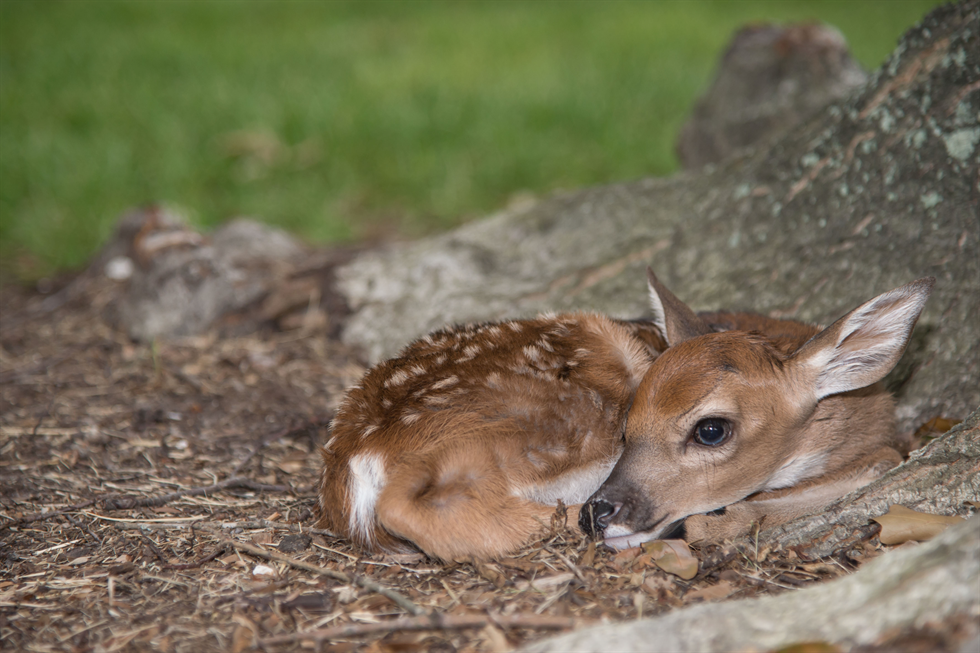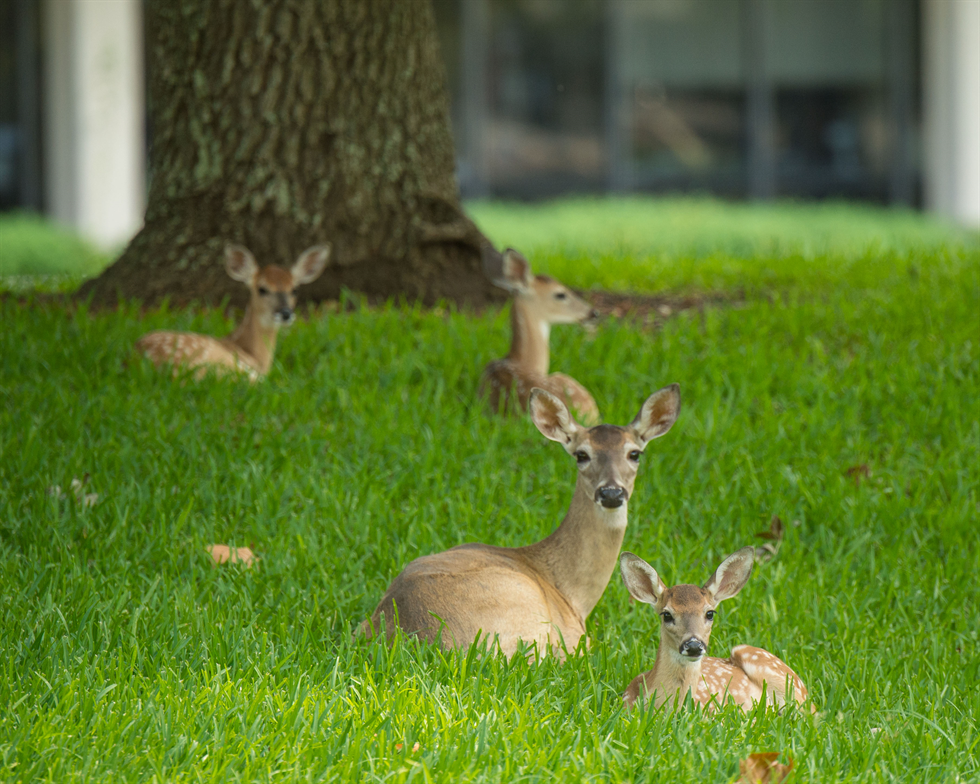Of deer and fawns: A cautionary tale
2017-07-19
NASA’s Johnson Space Center sits on 1,700 acres of lush, beautiful land. Day in and day out, the 10,000-person workforce at Johnson goes about their meaningful business, working to accelerate our understanding of the cosmos. Accompanying us on our daily schedules is a loyal and adorable crew of almost 300 deer and fawns on the campus. Though both captivating and sometimes oblivious to their surroundings, the deer and fawns must be treated with a sense of caution and respect if we are to coexist with these furry neighbors.
Meet Matt Strausser. As the wildlife biologist for Johnson, Strausser uses his background in biology and environmental management to oversee all matters related to wildlife on-site.
“Fawns are what we call baby deer,” Strausser said, “while does are female deer who happen to be the mothers of the fawns.”
Strausser said that fawns are typically born in late spring, between May and June. By the fall, fawns will have fully developed and are considered juveniles until they participate in mating season, which also occurs during the fall. Currently, NASA personnel are seeing an influx of fawns who have recently been born.
Many who see the fawns will see them without their mothers. Interestingly, the fawns haven’t been abandoned. The does deliberately choose to separate from their fawns to divert the attention of bobcats and coyotes.
“While they are still small and weak, fawns will typically remain hidden during their adolescence, until they grow big enough to keep up with their mothers,” Strausser said. Otherwise, they could fall victim to predators who also reside on campus.
To ensure the safety of their fawns, does will place their babies in discrete locations around the center to keep them hidden from predators. Throughout the day, mothers will occasionally come back to tend to their fawns and, sometimes, even move them to new locations to keep predators off their scent. Unfortunately, many fawns will be placed in the early morning, before many people get to work.
“This means that seemingly isolated hiding spots can turn into intersections of heavy human traffic come lunchtime,” Strausser said. In many cases, does will unknowingly hide their fawns in dangerous locations. “We have had cases where fawns are found sleeping under cars for shade from the sweltering heat. Other cases have involved fawns who unknowingly fall asleep near a mound of red ants.”
During instances like this, where you encounter a fawn that might be in danger or have cause for concern about wildlife on campus, please contact Facilities Work Control at 281-483-2038.
The sad reality is that most fawns will never reach adulthood, as they fall victim to the dangers around them. For the fawns that do live longer, their likelihood of reaching adulthood greatly increases. Given the low odds of survival for fawns, does will try to reproduce every year to increase the likelihood of their offspring reaching maturity.
“The reason why all deer reproduce and mate around the same times of the year is so that they can increase the odds of survival for their fawns,” Strausser said. The higher number of fawns can overwhelm predators and diminish the individual probability of a fawn being eaten.
In the words of Carl Sagan, “We are a relatively new species on a very antique planet.”
We alone are not the only inhabitants on this planet, and the Johnson team has a first-class seat to experience the beautiful nature and wildlife right outside our offices. The deer and fawns are here to stay. The better we understand our four-legged neighbors, the more we can do to protect and look out for them.
If you ever have any concerns about deer or other wildlife on campus, please do not hesitate to contact Facilities Work Control at 281-483-2038.

A fawn finds refuge from the heat under a tree. Image Credit: NASA/Lauren Harnett
David Lie-Tjauw
NASA Johnson Space Center
Meet Matt Strausser. As the wildlife biologist for Johnson, Strausser uses his background in biology and environmental management to oversee all matters related to wildlife on-site.
“Fawns are what we call baby deer,” Strausser said, “while does are female deer who happen to be the mothers of the fawns.”
Strausser said that fawns are typically born in late spring, between May and June. By the fall, fawns will have fully developed and are considered juveniles until they participate in mating season, which also occurs during the fall. Currently, NASA personnel are seeing an influx of fawns who have recently been born.
Many who see the fawns will see them without their mothers. Interestingly, the fawns haven’t been abandoned. The does deliberately choose to separate from their fawns to divert the attention of bobcats and coyotes.
“While they are still small and weak, fawns will typically remain hidden during their adolescence, until they grow big enough to keep up with their mothers,” Strausser said. Otherwise, they could fall victim to predators who also reside on campus.
To ensure the safety of their fawns, does will place their babies in discrete locations around the center to keep them hidden from predators. Throughout the day, mothers will occasionally come back to tend to their fawns and, sometimes, even move them to new locations to keep predators off their scent. Unfortunately, many fawns will be placed in the early morning, before many people get to work.
“This means that seemingly isolated hiding spots can turn into intersections of heavy human traffic come lunchtime,” Strausser said. In many cases, does will unknowingly hide their fawns in dangerous locations. “We have had cases where fawns are found sleeping under cars for shade from the sweltering heat. Other cases have involved fawns who unknowingly fall asleep near a mound of red ants.”
During instances like this, where you encounter a fawn that might be in danger or have cause for concern about wildlife on campus, please contact Facilities Work Control at 281-483-2038.
The sad reality is that most fawns will never reach adulthood, as they fall victim to the dangers around them. For the fawns that do live longer, their likelihood of reaching adulthood greatly increases. Given the low odds of survival for fawns, does will try to reproduce every year to increase the likelihood of their offspring reaching maturity.
“The reason why all deer reproduce and mate around the same times of the year is so that they can increase the odds of survival for their fawns,” Strausser said. The higher number of fawns can overwhelm predators and diminish the individual probability of a fawn being eaten.
In the words of Carl Sagan, “We are a relatively new species on a very antique planet.”
We alone are not the only inhabitants on this planet, and the Johnson team has a first-class seat to experience the beautiful nature and wildlife right outside our offices. The deer and fawns are here to stay. The better we understand our four-legged neighbors, the more we can do to protect and look out for them.
If you ever have any concerns about deer or other wildlife on campus, please do not hesitate to contact Facilities Work Control at 281-483-2038.

A fawn finds refuge from the heat under a tree. Image Credit: NASA/Lauren Harnett
David Lie-Tjauw
NASA Johnson Space Center

A day-old fawn resting in the shade outside of Building 8. Image Credit: NASA/Lauren Harnett

Fawns and their mothers are seen relaxing on Johnson Space Center's mall. Image Credit: NASA/Lauren Harnett

A fawn hides behind a traffic cone. Image Credit: NASA/Lauren Harnett

Fawns are often hidden by their mothers in seemingly isolated places ... that can oftentimes end up not being so isolated after all. Image Credit: NASA/Lauren Harnett







